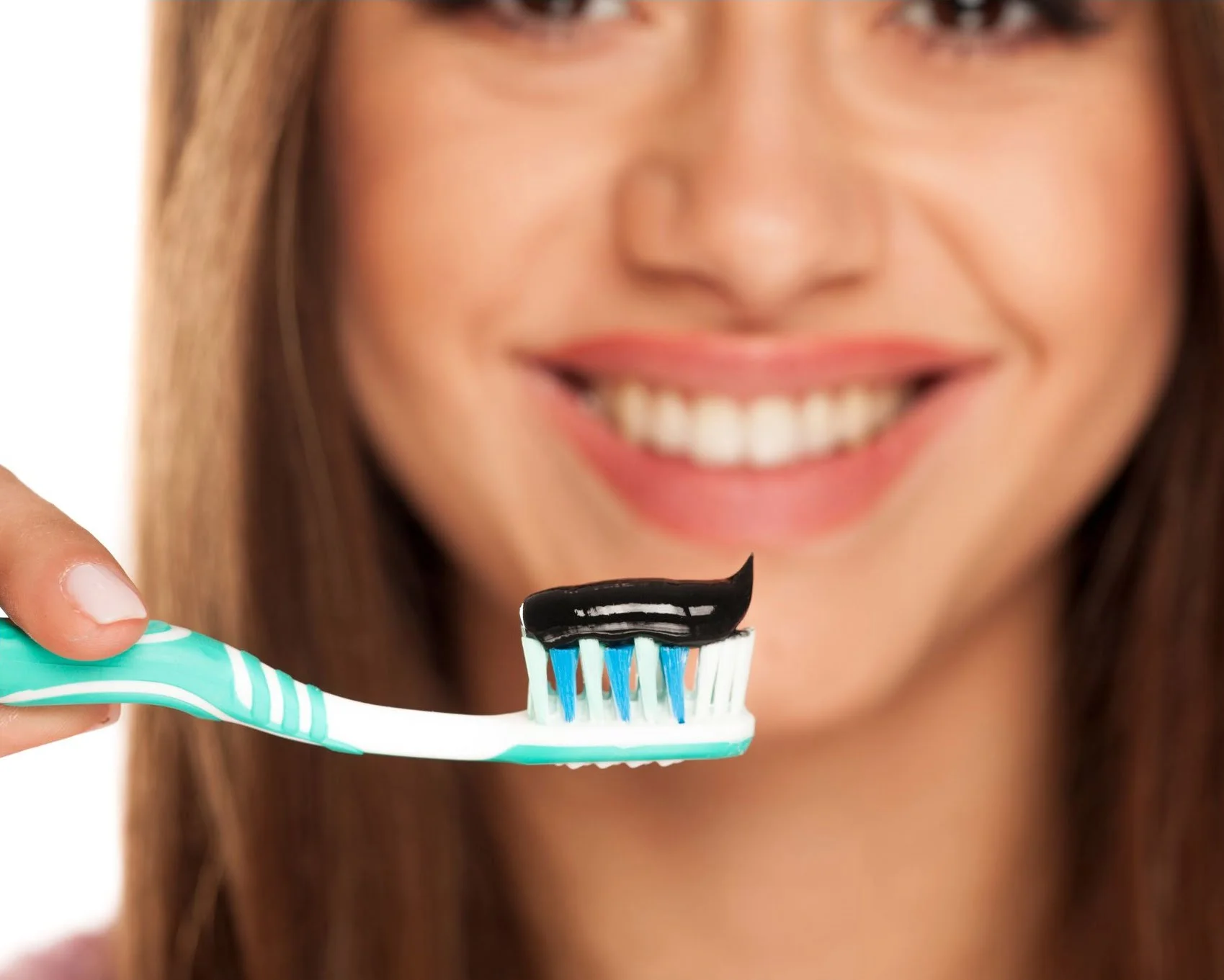Last Updated on: 1st July 2024, 12:15 pm
✓ Fact Checked 🕓
❙ Our team of writers, editors, and medical experts rigorously evaluates each article to ensure the information is accurate and exclusively cites reputable sources.
❙ We regularly assess how the content in this article aligns with current scientific literature and expert recommendations in order to provide the most up-to-date research.
In a world where a captivating smile is a symbol of confidence and charm, the pursuit of teeth whitening has evolved into a cultural phenomenon. Picture millions around the globe on a quest for that perfect, radiant grin. In this article, we embark on a journey to explore the rising trend of Activated Charcoal for Natural Teeth Whitening. Our mission is to unravel the effectiveness and safety of this dark horse in the realm of dental care.
Activated Charcoal for Natural Teeth Whitening
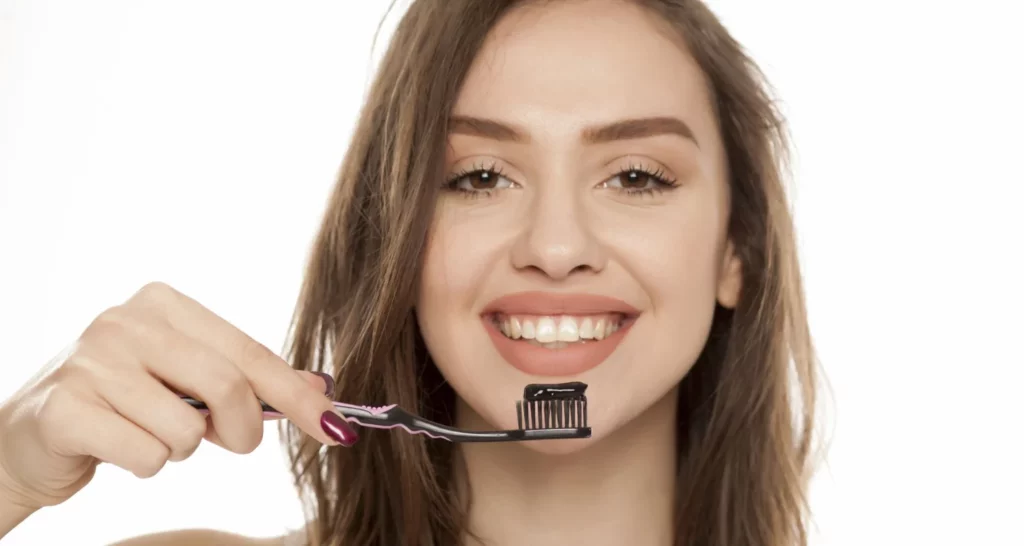
As societal preferences shift to sustainable and eco-friendly practices, the landscape of dental care has witnessed a remarkable transformation. A multitude of alternatives to conventional teeth-whitening methods has emerged, ranging from baking soda to oil pulling. Amid this sea of options, activated charcoal has emerged as a formidable contender. As we navigate the growing trend of natural and eco-friendly dental care practices, we pave the way for a deeper exploration of the wonders of Activated Charcoal for Natural Teeth Whitening.
What is Activated Charcoal?
Before delving into its dental applications, let’s demystify activated charcoal. Originating from finely ground natural sources like coconut shells or wood, it is a versatile substance with historical roots dating back centuries. Used for medicinal purposes and toxin absorption, its journey through time provides a context for modern applications. We’ll uncover the manufacturing process and delve into its multifaceted role beyond dental care.
7 Surprising Facts About Activated Charcoal for Natural Teeth Whitening
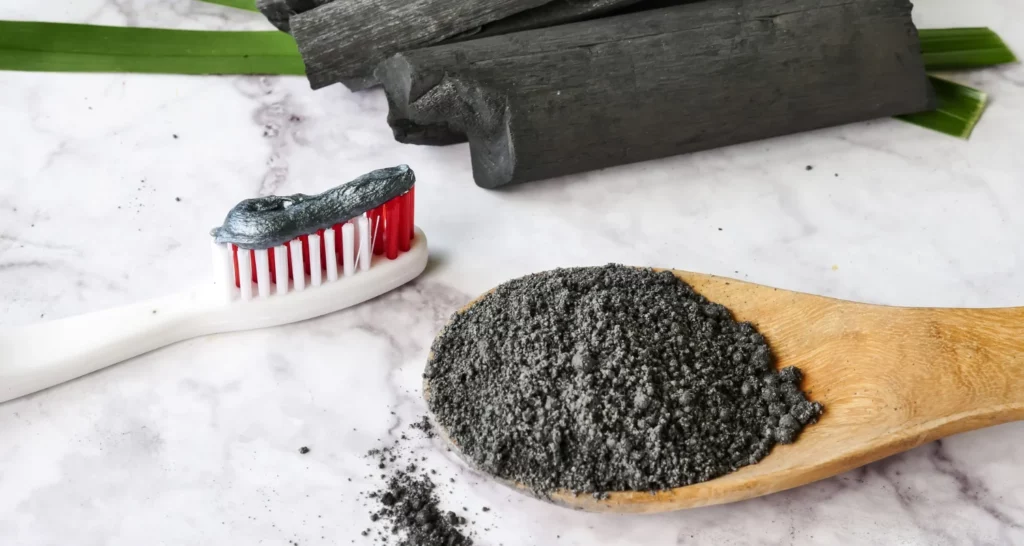
Prepare for a revelation as we present seven lesser-known facts about Activated Charcoal for Natural Teeth Whitening and oral healt. In the realm of dental care, myths and misconceptions often cloud the truth. We’ll debunk them here, clarifying the surprising truths that make activated charcoal a standout in the pursuit of a brighter smile. From its historical significance to its unexpected applications, these facts shed light on the multifaceted nature of activated charcoal.
1. Toxin absorption
Unique property: tiny pores act like magnets, absorbing impurities.
2. pH balance enhancement
Balancing act of charcoal for oral health: Maintains a balanced pH, preventing bacteria growth and cavities
3. Bad breath
Natural freshener: Acts as a breath freshener, enhancing overall oral hygiene.
4. Eco-friendly appeal
● Minimal Impact: products often have minimal packaging, supporting eco-friendly dental care.
● Natural Sourcing: sourced naturally, aligning with sustainability.
5. Moderation guideline
Guiding Principle: moderation crucial to avoid drawbacks like enamel wear.
6. Natural detoxifier
Historical roots: Used historically as a toxin absorber, extending to overall detoxification.
7. Targeted action on natural enamel
While activated charcoal primarily targets natural teeth enamel, it poses minimal threat to restoration or veneers.
DIY Activated Charcoal for Natural Teeth Whitening at Home
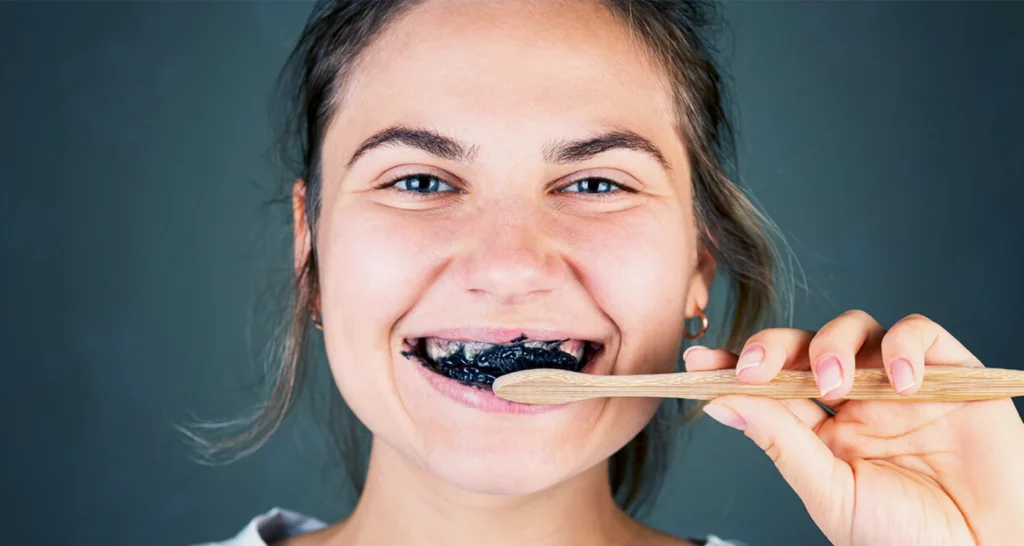
Steps:
1. Mix the base ingredients:
● Combine 2 tablespoons of activated charcoal powder and 2 tablespoons of coconut oil in a bowl.
● Add 1 teaspoon of baking soda for its mild abrasive properties.
● Optional: Introduce a few drops of peppermint essential oil for flavor.
2. Blend into a paste:
Stir the ingredients thoroughly until a smooth, consistent paste forms.
3. Storage:
Transfer the paste into a small jar or airtight container for convenient use.
4. Application:
● Use a soft-bristled toothbrush to apply a small amount of the paste onto your teeth and gently brush for 2 minutes, ensuring coverage on all surfaces.
5. Rinse thoroughly:
Spit out the charcoal residue and rinse your mouth thoroughly.
Considerations and Precautions about Activated Charcoal for Natural Teeth Whitening
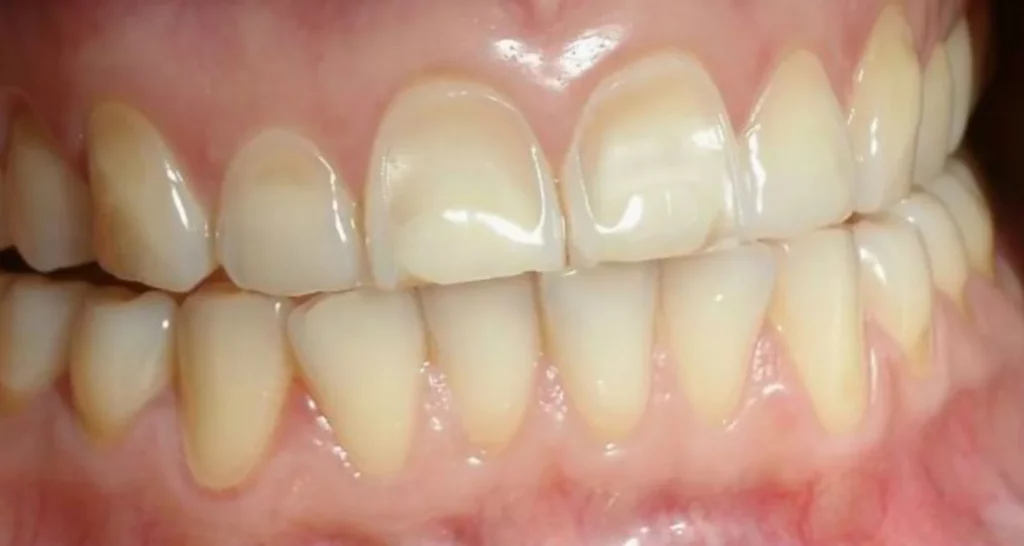
Incorporating Activated Charcoal for Natural Teeth Whitening into dental routines has gained popularity due to its adsorption qualities; theoretically, it binds to toxins and stains on the surface of the teeth. However, it’s crucial to approach this trend with caution due to potential risks and side effects. Activated charcoal’s abrasive nature can erode enamel over time, leading to increased sensitivity and even more susceptibility to staining. Erosion is irreversible, and once the enamel has been damaged, the protective layer of the teeth is compromised.
Dental professionals and experts recommend using Activated Charcoal for Natural Teeth Whitening sparingly and with gentle application to mitigate risks. Instead of making it a daily ritual, consider using products containing activated charcoal once a week or less. Always opt for a version specifically formulated for dental use to ensure it is safe and not too abrasive. It’s also wise to look for products with the American Dental Association (ADA) Seal of Acceptance, which indicates the product has been evaluated for safety and efficacy.
Moreover, integrating regular dental check-ups into your routine is essential to monitor any changes in your dental health and garner personalized advice. As with any product, individual experiences will vary, such that consulting with a dentist before introducing activated charcoal into your dental care regimen is the best way to ensure that it’s a safe option for you.
Conclusion
Activated charcoal has emerged as a popular alternative in the quest for natural teeth whitening, reflecting a shift towards sustainable and eco-friendly dental practices. Its historical use for toxin absorption and modern application in oral care highlights its multifaceted nature. Despite its potential benefits, such as toxin absorption, pH balance enhancement, and natural breath freshening, it is crucial to use Activated Charcoal for Natural Teeth Whitening with caution due to its abrasive properties, which can erode enamel and increase tooth sensitivity.
Dental professionals advise moderation and gentle application to mitigate risks, recommending the use of activated charcoal products specifically formulated for dental use and approved by organizations like the American Dental Association. Regular dental check-ups remain essential to monitor dental health and receive personalized advice. While Activated Charcoal for Natural Teeth Whitening can contribute to a brighter smile, it is vital to balance its use with professional guidance to ensure long-term oral health and prevent potential damage.
Frequently Asked Questions
How does activated charcoal for natural teeth whitening?
Activated charcoal is believed to bind to and absorb surface stains on teeth, including those caused by coffee, tea, red wine, and tobacco. Its porous nature allows it to attract and trap particles, providing a potential remedy for those seeking a natural way to brighten their smile.
Is it safe activated charcoal for natural teeth whitening?
Activated charcoal for natural teeth whitening is a safe option. Activated charcoal is a bit like that cool cousin who is always up for an exciting adventure but needs some guidance. Its abrasive nature might raise an eyebrow or two among dental pros, so the key is balance and moderation. Too much of anything, even the coolest cousin, can have its drawbacks.
What precautions should be taken with activated charcoal for natural teeth whitening?
a. Moderation is key: Overusing activated charcoal may lead to enamel wear. Use these recipes 1-3 times a week.
b. Gentle application: Apply with a soft toothbrush to avoid abrasive effects on enamel.
c. Monitor sensitivity: If you experience sensitivity, reduce the frequency or discontinue use.
d. Quality matters: Ensure you use high-quality, food-grade activated charcoal for safety.
e. Regular dental check-ups: Maintain regular dental check-ups to monitor your oral health.
What are the myths about activated charcoal for natural teeth whitening?
Myth # 1: Enamel harm
● Fact: Activated charcoal, in moderation, doesn’t harm tooth enamel.
● Balancing Act: It’s mildly abrasive, aiding stain removal, emphasizing the need for a balanced dental care routine.
Myth # 2: Overnight whitening
● Fact: Immediate results are a myth; consistent use over time leads to gradual whitening.
● Patience required: Achieving a brighter smile is a marathon, not a sprint.
Myth # 3: Dental restorations
● Fact: Generally safe, targeting enamel without significant harm to dental work.
● Targeted Action: Focuses on natural tooth surfaces.
Myth # 4: Brushing replacement
● Fact: Excellent supplement but doesn’t replace regular brushing.
● Dental recommendation: Dentists advise continuing with fluoride toothpaste and a soft brush.
Myth # 5: Universal effectiveness
● Fact: Results vary based on individual factors like stain type and overall dental health.
● Personalized Journey: Effectiveness is unique to each person’s dental journey.
Myth # 6: Sensitivity
● Fact: When used properly, activated charcoal doesn’t inherently cause sensitivity.
● Mitigating risk: Appropriate product choice and oral health practices help avoid sensitivity.
Share:
References
1. Keppetipola, N. M., Dissanayake, M., Dissanayake, P., Karunarathne, B., Dourges, M. A., Talaga, D., Servant, L., Olivier, C., Toupance, T., Uchida, S., Tennakone, K., Kumara, G. R. A., & Cojocaru, L. (2021). Graphite-type activated carbon from coconut shell: a natural source for eco-friendly non-volatile storage devices. RSC advances, 11(5), 2854–2865. https://doi.org/10.1039/d0ra09182k
2. Kiyoshi, Tanemura. 2020. “Activated Charcoal as an Effective Additive for Alkaline and Acidic Hydrolysis of Esters in Water – ScienceDirect.” October 29, 2020. https://www.sciencedirect.com/science/article/abs/pii/S0040403920309485
3. Santos-Longhurst, A. (Jun 18, 2019). Charcoal toothpaste for teeth whitening: Does it work? Healthline. https://www.healthline.com/health/dental-and-oral-health/charcoal-toothpaste
4. Torborg, L. (Jul 28, 2015). Mayo Clinic Q and A: Many safe choices available to help whiten teeth. Mayo Clinic News Network. https://newsnetwork.mayoclinic.org/discussion/mayo-clinic-q-and-a-many-safe-choices-available-to-help-whiten-teeth/
5. Maciel, J. L. B., Geng Vivanco, R., & Pires-de-Souza, F. de C. P. (2023). Remineralization, color stability and surface roughness of tooth enamel brushed with activated charcoal‐based products. Et al [Journal of Esthetic and Restorative Dentistry], 35(7), 1144–1151. https://onlinelibrary.wiley.com/doi/10.1111/jerd.13057
6. Palandi, Samuel da Silva, Matheus Kury, Mayara Zaghi Dal Picolo, Camila Siqueira Silva Coelho, and Vanessa Cavalli. 2020. “Effects of Activated Charcoal Powder Combined with Toothpastes on Enamel Color Change and Surface Properties.” Journal of Esthetic and Restorative Dentistry: Official Publication of the American Academy of Esthetic Dentistry … [et Al.] 32 (8): 783–90. https://onlinelibrary.wiley.com/doi/abs/10.1111/jerd.12646
7. Silberman, Jason, Michael A. Galuska, and Alan Taylor. 2024. “Activated Charcoal.” In StatPearls. Treasure Island (FL): StatPearls Publishing. http://www.ncbi.nlm.nih.gov/books/NBK482294/.


